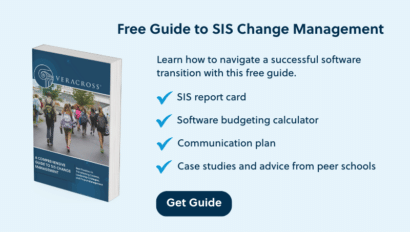
Transitioning to a new student information system takes research, planning, approval, and communication.
Regardless of where you are on your search for a new SIS, this 10-step checklist will help you navigate the process from start to finish. This checklist is designed with a 6 to 8 week timeline in mind but it can be finished sooner or later, depending on your deadline.
Step One: Breathe
Many schools feel rushed to choose and adapt to a new system before the next school year — but rest assured, you still have plenty of time. In fact, it’s not uncommon for a school to sign on to a new platform in the spring and start implementation in the summer prior to the next school year.
Pro tip: You’re probably further along than you realize. You likely already know many of the key requirements for your next SIS. The next step is to document them — more on that below.
Step Two: Confirm your Budget
While budgeting is an important factor in your decision, it shouldn’t be your only consideration. Start by calculating your current spend and use that as a benchmark to pitch to leadership. When comparison shopping, think about addition by subtraction: if the new system is robust enough, you might be able to cancel other subscriptions and recoup the cost.
“It’s really important to keep an open mind about what each system offers.” – Bill Stites, Director of Technology at Montclair Kimberley Academy
Pro tip: Bring leadership into the conversation early and provide a potential budget range. You don’t want any surprises!
Step Three: Define Responsibilities
It’s important to establish roles and clearly define expectations early on in your search. You want to make the process inclusive of all key departments but avoid slowing things down with too many cooks in the kitchen. Think about the entire scope of your SIS: which groups will use the system, how it will be used, and who is responsible for maintaining the system. This should not fall on the technology department alone.
Pro tip: A responsibility model like a RACI (Responsible, Accountable, Consulted, or Informed) or DACI (Driver, Approver, Contributor, Informed) chart can help you get organized and set expectations.
Step Four: Confirm Major Requirements
Now it’s time to define “The Why.” Why are you looking for a new SIS? What do you need from your new system? Identify your primary motivation for switching to a new system and outline all key departments. Make sure to prioritize your parents and students for the best user experience possible.
Pro tip: If you’re working at an accelerated pace, you can skip the Request for Proposal. Instead, compile your requirements in a one-page document and send it to your vendor to get answers before the live demo.
Step Five: Determine Your Timeline
Now that you’ve outlined your major requirements and responsibilities, you can work backwards to determine your timeline. Phase the implementation based on key departments and their restrictions. Some might need to move faster than others — plan accordingly. Communicate your timeline needs to all potential vendors and ask them to provide a sample timeline in return. Once established, share your timeline with all key constituents for full transparency.
Pro tip: Remember to prioritize your parents and students during this stage.
Step Six: Use Your Network
Word-of-mouth recommendations from trusted peers and aspirational schools can help you get insight as you shop around. Create a simple survey to send to your connections and ask them what they like or dislike about their current provider. Use the informal connections you have to get the most information you can.
Pro tip: Regional and national associations like ATLIS can also be a great resource for technology departments and leadership.
Step Seven: Contact Vendors
Identify your top 3 to 5 vendors and ask them for an initial product demo. At this stage, prioritize the demos for your key departments and limit the audience to a smaller size based on crucial staff. Be mindful of everyone’s time and be clear on the timeline.
Pro tip: Remember that the more people involved, the slower the process will move.
Step Eight: Survey Key Constituents
Poll your internal departments to understand how your users feel about the potential new system. Stay away from technical questions and ask open-ended questions that focus on gut reactions. How do you feel about this system? Be sure to gather feedback from all user groups including parents, students, and staff to get a full report.
Pro tip: Use a survey tool — it’s more efficient and easier to analyze.
Step Nine: Get Final Demos
At this stage, you should be able to narrow down your options to the top 2 to 3 vendors. Ask for a final demo from each vendor and invite all key departments that have not seen the system yet. This is your chance to ask lingering questions and come to a final decision.
Pro tip: This should feel like a natural conclusion, not an “ah-ha” moment.
Step Ten: Selection and Communication
Now it’s time to pick the winning SIS! Remember “The Why” and determine which system will allow your school to grow and adapt alongside it. Develop a communication plan to present your decision to major constituents including faculty, staff, and the parent association. Emphasize why the new SIS matters to them and how it will improve their experience.
Pro tip: Pick a system that your future self will thank you for.
Veracross has helped hundreds of schools transition to a new student information system. Book a free demo to chat with our sales team and learn how we can help you, too.




